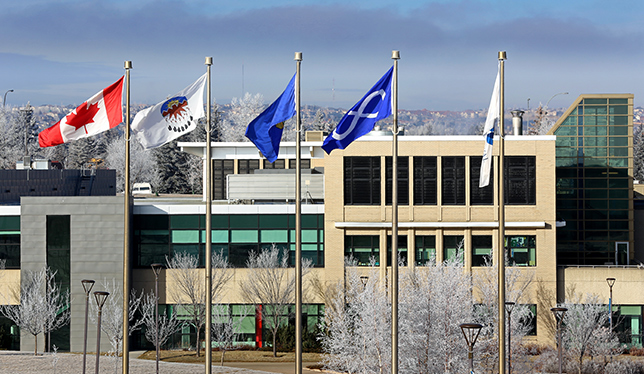When Steve Kootenay-Jobin watched the Treaty 7 and Métis nation flags rise at Mount Royal University this past November, it was more than a symbolic gesture to him – it felt like a major step towards reconciliation. The flag-raising marked the roll-out of the university’s Indigenous Strategic Plan and will fly permanently on campus.
A member of the Stoney-Nakoda Nation, Mr. Kootenay-Jobin works as the housing and events coordinator at Mount Royal’s Iniskim Centre, a campus resource for Indigenous students. He says the flags are an important recognition of the Indigenous nations students and staff belong to because “for so many years postsecondary institutes were not that welcoming to Indigenous peoples.”

On its website, Mount Royal acknowledges its presence on “the hereditary lands of the Niitsitapi (Blackfoot), Iyarhe Nakoda, Tsuut’ina and Métis nations.” Mr. Kootenay-Jobin says the university represents a breadth of Indigenous peoples, so the flags show “that Mount Royal is stepping up to the plate, that we’re here to support our Indigenous learners, and to work on reconciliation.”
The idea to raise the flags began with Candice Merrill, a security services officer at the school. In the fall, she was scrolling through her Facebook feed when she saw a post showing the Treaty 7 flag flying at Calgary’s city hall. Ms. Merrill, who works closely with the Iniskim Centre, says her first thought was: “How come we don’t do this?”
She approached Mount Royal president David Docherty about it. Dr. Docherty acknowledged that he had wanted to fly the flag for some time, but administrators were having trouble deciding which ones would best suit the campus. Ms. Merrill turned to the Iniskim Centre for guidance and director John Fischer suggested the addition of the Métis flag to reflect a large number of the school’s Indigenous students.
Both Mr. Kootenay-Jobin and Ms. Merrill say making the flags a permanent feature on campus was never in question. What Ms. Merrill says she didn’t expect was the overwhelmingly positive response from Indigenous students and local members of Treaty 7 nations. “I don’t think I realized how much it would really mean to the Treaty 7 people.”
Mr. Kootenay-Jobin echoed this, adding that it’s also an opportunity for non-Indigenous students to engage more with issues like reconciliation, because “keeping us separate has not worked in the past.” He says other postsecondary institutions should take similar steps to indigenize their campuses. “Representation is a huge part” of that, he says, adding that it’s time for institutions to “knock down those barriers so that Indigenous students feel accepted, and they feel a sense of identity and welcoming.”
Thompson Rivers U in Kamloops has taken this one step further: http://inside.tru.ca/2010/04/01/bilingual-signs-stop-traffic-at-tru/